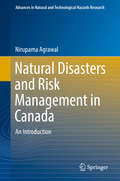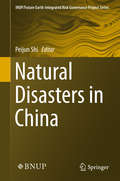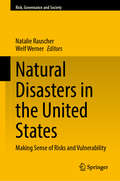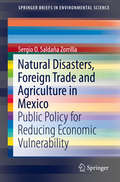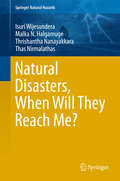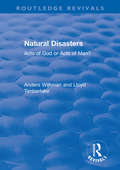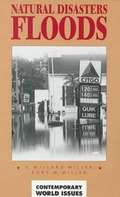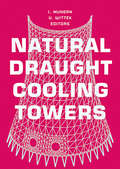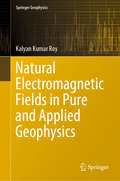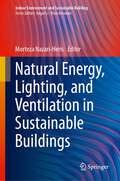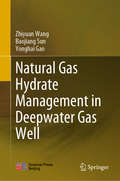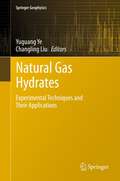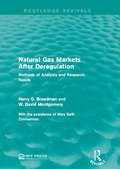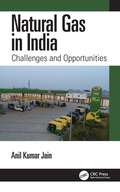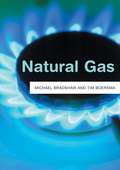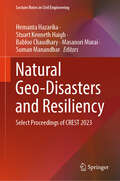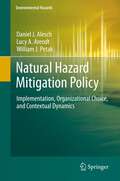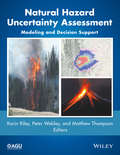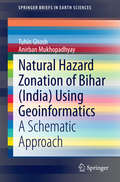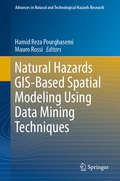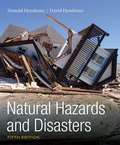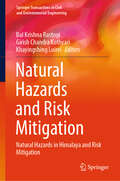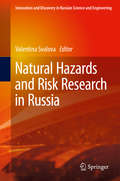- Table View
- List View
Natural Disasters and Risk Management in Canada: An Introduction (Advances In Natural And Technological Hazards Research #49)
by Nirupama AgrawalThese chapters provide valuable and comprehensive information on a variety of hazards, including both scientific and social aspects of disasters. The work introduces the concept of large, medium and small scale hazards, and includes many useful case studies as well as working examples of theoretical concepts.As readers will acknowledge, today the distinction between natural and technological hazards is becoming blurred and a new concept of NATECH hazards is evolving. For permanent hazards (such as tides, wind waves, coastal erosion and climate change) routine predictions are made, whereas for evanescent hazards (including droughts, sea level rise, and coastal subsidence), monitoring of various parameters is the norm. Only for episodic hazards (for example hurricanes, winter storms, tsunamis, and river floods), early warning systems are used, with varying degrees of success.The book explores how, for certain episodic hazards like tornadoes, landslides, forest fires, snow avalanches, and volcanic eruptions, the early warning systems are still in various stages of development. Readers will gain knowledge of theoretical and practical concepts of risk evaluation which assist in better understanding of disaster dynamics, and readers will become better equipped in quantification of disaster risk and vulnerability. The author explains how risk reduction initiatives, taking into account stakeholders’ participation and perception, can provide a roadmap to building resilient communities and cities.This book will be useful not only to practitioners of disaster management but also to research scholars and graduate students. It is highly readable and will appeal more broadly too, to all those who are interested in the very latest thinking on, and expert analysis of, hazards and disasters.
Natural Disasters in China
by Peijun ShiThis is the first English language book that systematically introduces the spatial and temporal patterns of major natural disasters in China from 1949 to 2014. It also reveals natural disaster formation mechanisms and processes, quantifies vulnerability to these disasters, evaluates disaster risks, summarizes the key strategies of integrated disaster risk governance, and analyzes large-scale disaster response cases in recent years in China. The book can be a good reference for researchers, students, and practitioners in the field of natural disaster risk management and risk governance for improving the understanding of natural disasters in China.
Natural Disasters in the Ottoman Empire
by Yaron AyalonThis book explores the history of natural disasters in the Ottoman Empire and the responses to them on the state, communal, and individual levels. Yaron Ayalon argues that religious boundaries between Muslims and non-Muslims were far less significant in Ottoman society than commonly believed. Furthermore, the emphasis on Islamic principles and the presence of Islamic symbols in the public domain were measures the state took to enhance its reputation and political capital occasional discrimination of non-Muslims was only a by-product of these measures. This study sheds new light on flight and behavioral patterns in response to impending disasters by combining historical evidence with studies in social psychology and sociology. Employing an approach that mixes environmental and social history with the psychology of disasters, this work asserts that the handling of such disasters was crucial to both the rise and the fall of the Ottoman Empire. "
Natural Disasters in the United States: Making Sense of Risks and Vulnerability (Risk, Governance and Society #22)
by Welf Werner Natalie RauscherThis volume examines the history of natural disasters in the United States and the nation's ongoing struggles with long-term disaster preparedness and response. It explores the political, economic, and cultural factors that have shaped the country's vulnerability. It highlights why, despite its vast resources, the United States has remained one of the most resistant actors in recognizing and mitigating disaster risk. Bringing together contributions from a variety of fields, this book analyzes the role of political institutions, media narratives, and cultural perceptions in shaping disaster policy. It examines key historical events to identify patterns of governance failure and missed opportunities to build resilience. Ultimately, this volume provides crucial insights into the historical baggage that the United States brings to multilateral climate negotiations, helping to explain its often frustrating role on the international stage. This book is essential reading for students, researchers, and scholars in the social sciences, humanities, and environmental studies, as well as policymakers and practitioners seeking a deeper understanding of the challenges and shortcomings of U.S. disaster mitigation policy. Chapter &“&‘Becoming Green:&’ Resilient and Green Building as Risk Mitigation in Atlanta, Georgia&” is available open access under a Creative Commons Attribution 4.0 International License via link.springer.com.
Natural Disasters, Foreign Trade and Agriculture in Mexico
by Sergio O. Saldaña ZorrillaThis work responds to the increasing global need of measuring and analyzing impacts, vulnerabilities and coping capacity of countries, regions and communities regarding climate change, extreme weather conditions, natural disasters and institutional constraints. The case of Mexico, analyzed in this work, provides lessons for further developing countries to assess natural disasters vulnerability, for making informed adaptation decisions and to optimize resources for reducing country and community vulnerability. This book's analyses contribute to the current debate of the long-term economic impact of natural disasters (hurricanes, earthquakes, etc. ), as well as offer an integral methodology combining natural and social sciences for studies of country and community level vulnerability to climate change. The lessons derived from this analysis provide useful elements for the design and improvement of governmental policies concerning social and economic development as well. In addition, the desegregation of this analysis has the advantage of facilitating the design and evaluation of governmental projects at municipal, sub-national and national level, as well as provides conceptual-empirical elements for international cooperation in matters of disaster risk reduction, climate change adaptation, rural development and poverty reduction.
Natural Disasters, When Will They Reach Me?
by Isuri Wijesundera Malka N. Halgamuge Thrishantha Nanayakkara Thas NirmalathasThe expected time of impact, also known as the mean first passage time (MFPT) to reach failure, is a critical metric in the management of natural disasters. The complexity of the dynamics governing natural disasters lead to stochastic behaviour. This book shows that state transitions of many such systems translate into random walks on their respective state spaces, biased and shaped by environmental inhomogeneity. Thus the probabilistic treatment of those random walks gives valuable insights of expected behaviour. A comprehensive case study of predicting cyclone induced flood is followed by a discussion of generic methods that predict MFPT addressing directional bias. This is followed by discussing MFPT prediction methods in systems showing network inhomogeneity. All presented methods are illustrated using real datasets of natural disasters. The book ends with a short discussion of possible future research areas introducing the problem of predicting MFPT for bush-fire propagation.
Natural Disasters: Acts of God or Acts of Man? (Routledge Revivals)
by Anders Wijkman Lloyd TimberlakeOriginally published in 1984 Natural Disasters shows how misleading the term “natural disaster” can be. Forces of nature such as earthquakes, cyclones and extreme variations in weather can trigger disasters, but in many Third World countries it is environmental degradation, poverty and rapid population growth which turn a natural hazard into major disaster. This book questions whether the rich nations’ usual response to disaster – fast, short-lived emergency assistance – is any longer adequate. Today, most major disasters are “development” gone wrong, development which puts millions of poor people on the margins of existence. Disaster relief alone is like bandaging a rapidly growing wound. The appropriate response must include an element of true development – development which reduces rather than increases vulnerability to disasters.
Natural Disasters: Floods
by E. Willard Miller Ruby M. MillerThe Millers (geography, Pennsylvania State University) discuss the origin of floods, their prediction and control, floodplain management, and insurance. Floods are classified according to origin: excessive rain from hurricanes, undersea earthquakes, and wind-driven tidal waves. Also included are chapters on organizations devoted to flood problems, and relevant laws and regulations. Special attention is given to the midwest flood of 1993, the Johnstown flood (1889), the Big Thompson Canyon flood (1972) and the Susquehanna River flood (1972). A bibliography, a list of audio-visual materials, and a glossary complete the volume. Annotation c. Book News, Inc., Portland, OR (booknews.com)
Natural Draught Cooling Towers: Proceedings of the Fifth International Symposium on Natural Draught Cooling Towers, Istanbul, Turkey, 20-22 May 2004
by I. Mungan U. WittekThe world's most experienced scientists and professionals working on cooling towers gathered at the 5th International Symposium on Natural Draught Cooling Towers to discuss the latest developments in this area and exchange knowledge and experiences. This book comprises 43 contributions on the latest developments in the field of natural draught cool
Natural Electromagnetic Fields in Pure and Applied Geophysics (Springer Geophysics)
by Kalyan Kumar RoyThis research monograph presents all the branches of geophysics based on natural electromagnetic fields and their associated subjects. Meant for postgraduate and research level courses, it includes research guidance and collection of magnetotelluric data in some parts of Eastern India and their qualitative and quantitative interpretation. Specific topics highlighted include (i) Electrotellurics, (ii) Magnetotellurics, (iii) Geomagnetic Depth Sounding and Magnetometer Array Studies, (iv) Audio Frequency Magnetotellurics and Magnetic Methods, (v) Marine Magnetotelluric and Marine Controlled Source Electromagnetic Methods, (vi) Electrical Conductivity of Rocks and Minerals and (vii) Mathematical Modelling and Some Topics on Inversion needed for Interpretation of Geoelectrical Data.
Natural Encounters: Biking, Hiking, and Birding Through the Seasons
by Bruce M. BeehlerA twelve-month excursion through nature’s seasons as recounted by a lifetime naturalist In this “personal encyclopedia of nature’s seasons,” lifetime naturalist Bruce Beehler reflects on his three decades of encountering nature in Washington, D.C. The author takes the reader on a year-long journey through the seasons as he describes the wildlife seen and special natural places savored in his travels up and down the Potomac River and other localities in the eastern and central United States. Some of these experiences are as familiar as observing ducks on the National Mall in Washington, D.C., or as unexpected as collecting fifty-million-year-old fossils on a Potomac beach. Beyond our nation’s capital, Beehler describes trips to nature’s most beautiful green spaces up and down the East Coast that, he says, should be on every nature lover’s bucket list. Combining diary entries, riffs on natural subjects, field trips, photographs, and beautiful half-tone wash drawings, this book shows how many outdoor adventures are out there waiting in one’s own backyard. The author inspires the reader to embrace nature to achieve a more peaceful existence.
Natural Energy, Lighting, and Ventilation in Sustainable Buildings (Indoor Environment and Sustainable Building)
by Morteza Nazari-HerisThis book explores the theoretical background and provides an experimental analysis of using natural energy resources in sustainable building design. It brings together an international group of contributors focusing on ways natural energy, lighting, and ventilation can improve the performance of electrical, lighting, and mechanical systems. Contributions explore how natural resources can contribute to sustainable development goals while meeting energy demands and maintaining acceptable interior air quality and natural illumination needs. Coverage includes green building design, renewable energy integration, photovoltaic systems, small-scale wind turbines, natural lighting, and natural ventilation. Natural Energy, Lighting, and Ventilation in Sustainable Buildings offers practical and promising solutions for novel challenges in sustainable design for electrical engineers, energy engineers, architectural engineers, and related professionals, as well as researchers and developers from engineering science.
Natural Gas Hydrate Management in Deepwater Gas Well
by Baojiang Sun Zhiyuan Wang Yonghai GaoThis book chiefly describes the theories and technologies for natural gas hydrate management in deepwater gas wells. It systematically explores the mechanisms of hydrate formation, migration, deposition and blockage in multiphase flow in gas-dominated systems; constructs a multiphase flow model of multi-component systems for wells that takes into account hydrate phase transition; reveals the influence of hydrate phase transition on multiphase flows, and puts forward a creative hydrate blockage management method based on hydrate blockage free window (HBFW), which enormously improves the hydrate prevention effect in deepwater wells. The book combines essential theories and industrial technology practice to facilitate a deeper understanding of approaches to and technologies for hydrate management in deepwater wells, and provides guidance on operation design. Accordingly, it represents a valuable reference guide for both researchers and graduate students working in oil and gas engineering, offshore oil and gas engineering, oil and gas storage and transportation engineering, as well as technical staff in the fields of deepwater oil and gas drilling, development, and flow assurance.
Natural Gas Hydrates
by Changling Liu Yuguang Ye"Natural Gas Hydrates: Experimental Techniques and Their Applications" attempts to broadly integrate the most recent knowledge in the fields of hydrate experimental techniques in the laboratory. The book examines various experimental techniques in order to provide useful parameters for gas hydrate exploration and exploitation. It provides experimental techniques for gas hydrates, including the detection techniques, the thermo-physical properties, permeability and mechanical properties, geochemical abnormalities, stability and dissociation kinetics, exploitation conditions, as well as modern measurement technologies etc. This book will be of interest to experimental scientists who engage in gas hydrate experiments in the laboratory, and is also intended as a reference work for students concerned with gas hydrate research. Yuguang Ye is a distinguished professor of Experimental Geology at Qingdao Institute of Marine Geology, China Geological Survey, China. Professor Changling Liu works at the Qingdao Institute of Marine Geology, China Geological Survey, China.
Natural Gas Markets After Deregulation: Methods of Analysis and Research Needs (Routledge Revivals)
by Harry G. Broadman W. David MontgomeryOriginally published in 1983, Broadman and Montgomery present an agenda for further research into deregulated natural gas markets by relating natural gas production, transmission and distribution with the economic function of contracts and local distribution companies. This work raises fundamental issues that could arise with the deregulation of the natural gas industry and outlines analytical methods that could be used to predict any problems that might arise and possible changes to policy. This title is of interest to students of Environmental Studies and professionals.
Natural Gas in India: Challenges and Opportunities
by Anil Kumar JainThis book provides a detailed discussion on India’s energy mix including descriptive use of the Shannon Wiener diversity index for numerically comparing India’s diversity in energy supply with other leading energy-consuming countries. The likely supply scenarios of both domestic and imported gas, and price competitiveness with competing fuels in differing consuming sectors, have also been presented. Overall, it covers energy systems, a comparison of the Indian natural gas economy with other countries and a scenario-based analysis of gas demand in India in 2030. Features: Presents a well-structured and robust thesis on the challenges and opportunities for natural gas in India’s energy future. Draws upon key insights, lessons and ways forward from the gas sector reform process. Addresses the energy transition scenario towards net zero. Includes comparative analysis of India’s diversity of commercial primary energy supply. Uses granular data and visual representations of the same to convey the key arguments. This book is aimed at oil and gas industry stakeholders including professionals, business executives, techno-managerial personnel and students in chemical engineering.
Natural Gas: The Challenges Of Growth In China, India, Japan And Korea (Resources)
by Tim Boersma Michael J. BradshawIs natural gas the ‘bridge’ to our low carbon future? If it replaces coal in the power industry and develops as an alternative transportation fuel, natural gas has the potential to play a greater role in the current low carbon energy transition. But such a future for natural gas is by no means certain. In this timely volume, Mike Bradshaw and Tim Boersma offer a sober and balanced assessment of a global gas industry whose fortunes hang in the balance. They examine the emergence of shale gas in North America and assesses the prospects for a wider shale gas revolution. Russia’s key role in global gas markets, is also explored, both in terms of the geopolitics of Russia-EU gas relations and the prospects for expanded Russian exports to the Asia-Pacific region. The exploitation of unconventional gas reserves and the expansion of liquefied natural gas (LNG) production capacity has indeed heralded a new age of plentiful and affordable natural gas. Yet, as the authors ably show, gas will not realise its potential unless it can displace coal in future energy demand growth in Asia and overcome the many geopolitical challenges that will shape its ongoing role in the global energy system.
Natural Geo-Disasters and Resiliency: Select Proceedings of CREST 2023 (Lecture Notes in Civil Engineering #445)
by Hemanta Hazarika Stuart Kenneth Haigh Babloo Chaudhary Masanori Murai Suman ManandharThis book presents select proceedings of the 2nd International Conference on Construction Resources for Environmentally Sustainable Technologies (CREST 2023), and focuses on sustainability, promotion of new ideas and innovations in design, construction and maintenance of geotechnical structures with the aim of contributing towards climate change adaptation and disaster resiliency to meet the UN Sustainable Development Goals (SDGs). It presents latest research, information, technological advancement, practical challenges encountered, and solutions adopted in the field of geotechnical engineering for sustainable infrastructure towards climate change adaptation. This volume will be of interest to those in academia and industry alike.
Natural Hazard Mitigation Policy
by William J. Petak Daniel J. Alesch Lucy A. ArendtThe negative consequences of natural hazard events are staggering and growing. Governments are acting to increase community resilience, reduce losses, and facilitate recovery, but these actions do not always yield anticipated consequences. This book is a compelling interdisciplinary analysis of California's efforts to ensure that acute care hospitals survive earthquakes and continue to function in the aftermath. The book weaves together several threads essential to understanding the effectiveness of public policies intended to reduce the consequences of natural hazard events: public policy design and administration, the hazard mitigation investment decision made by targeted organizations, and contextual dynamics. "A terrific study of shortfalls in the implementation of risk-reduction policy -- highly readable, full of insights, and very policy relevant." Peter J. May, Donald R. Matthews Distinguished Professor of American Politics, University of Washington, Seattle USA "This is an exceptional book by three of the leading hazard mitigation researchers and must reading for both scholars and practitioners in the field." William A. Anderson, National Research Council, National Academy of Sciences.
Natural Hazard Uncertainty Assessment: Modeling and Decision Support
by Matthew Thompson Karin Riley Peter WebleyUncertainties are pervasive in natural hazards, and it is crucial to develop robust and meaningful approaches to characterize and communicate uncertainties to inform modeling efforts. In this monograph we provide a broad, cross-disciplinary overview of issues relating to uncertainties faced in natural hazard and risk assessment. We introduce some basic tenets of uncertainty analysis, discuss issues related to communication and decision support, and offer numerous examples of analyses and modeling approaches that vary by context and scope. Contributors include scientists from across the full breath of the natural hazard scientific community, from those in real-time analysis of natural hazards to those in the research community from academia and government. Key themes and highlights include: Substantial breadth and depth of analysis in terms of the types of natural hazards addressed, the disciplinary perspectives represented, and the number of studies included Targeted, application-centered analyses with a focus on development and use of modeling techniques to address various sources of uncertainty Emphasis on the impacts of climate change on natural hazard processes and outcomes Recommendations for cross-disciplinary and science transfer across natural hazard sciences This volume will be an excellent resource for those interested in the current work on uncertainty classification/quantification and will document common and emergent research themes to allow all to learn from each other and build a more connected but still diverse and ever growing community of scientists.
Natural Hazard Zonation of Bihar (India) Using Geoinformatics
by Tuhin Ghosh Anirban MukhopadhyayWith increased climate variability, aggravated natural hazards in the form of extreme events are affecting the lives and livelihoods of many people. This work serves as a basis for formulating a 'preparedness plan' to ensure the effective policy formulation for planned development. Increased demand and competition with a high degree of variability have forced people to struggle in order to prosper. Good governance and innovative policy formulation are necessary to create a resilient society. This may promote a paradigm shift in the mindset on and perceptions of natural hazards and their impacts on development and growth. This new perspective will make people more concerned about minimizing the loss of life, property, and environmental damage and directly safeguard the development process. This book presents a detailed methodological approach to monitoring meteorological, hydrological, and climate change aspects to help resolve issues related to our environment, resources, and economies in the changing climate situation.
Natural Hazards GIS-Based Spatial Modeling Using Data Mining Techniques (Advances In Natural And Technological Hazards Research #48)
by Hamid Reza Pourghasemi Mauro RossiThis edited volume assesses capabilities of data mining algorithms for spatial modeling of natural hazards in different countries based on a collection of essays written by experts in the field. The book is organized on different hazards including landslides, flood, forest fire, land subsidence, earthquake, and gully erosion. Chapters were peer-reviewed by recognized scholars in the field of natural hazards research. Each chapter provides an overview on the topic, methods applied, and discusses examples used. The concepts and methods are explained at a level that allows undergraduates to understand and other readers learn through examples. This edited volume is shaped and structured to provide the reader with a comprehensive overview of all covered topics. It serves as a reference for researchers from different fields including land surveying, remote sensing, cartography, GIS, geophysics, geology, natural resources, and geography. It also serves as a guide for researchers, students, organizations, and decision makers active in land use planning and hazard management.
Natural Hazards and Disasters (Fifth Edition)
by Donald Hyndman David HyndmanSucceed in your course with NATURAL HAZARDS AND DISASTERS, 5e. The authors provide easy-to-understand coverage of the geological processes that underlie disasters, explore the impact these processes have on humans and vice versa, and analyze strategies for mitigating these hazards' physical and financial harm. From timely information on recent natural disasters in the United States and around the world to insights on earthquakes associated with fracking, this fascinating book provides the up-to-date information you need to analyze potential hazards and take the steps necessary to survive a natural disaster.
Natural Hazards and Risk Mitigation: Natural Hazards in Himalaya and Risk Mitigation (Springer Transactions in Civil and Environmental Engineering)
by Bal Krishna Rastogi Girish Chandra Kothyari Khayingshing LuireiThe book is on latest investigations of natural hazards like earthquakes, landslides, and glacial hazards carried out in last few years. Review papers are on the crustal structure of Himalaya based on latest studies through tomography and receiver transfer function. The seismotectonic models inferred from detailed modelling are also presented. Papers are on shallow soil/sediment structures inferred from passive seismic data, and also on estimation of strong ground motion. Several papers are on landslides and slope stability and two papers on glacial Hazards. A paper suggests multidisciplinary investigations for landslide and glacial hazards. Most of the papers are on investigations in J&K and western Himalaya which have come out for the first time. The results will be useful for planning risk mitigation. One paper is on safety of heritage structures of Ahmedabad UNESCO Heritage Site. Four papers give estimates of active deformation using PSINsar data in different regions. Two papers are on precursors. One review paper relates GPS results with earthquakes. Velocities of inferred movements in different parts of Himalaya are interpreted as partitions of active zones. This may preclude occurrence of mega earthquakes in Himalaya. Some papers show maps of VS30. One paper illustrates liquefaction potential at a dam site. Some papers outlay strategies for multidisciplinary research for risk mitigation of multi hazards. This book can serve as a valuable resource for researchers and professionals interested in the field of natural hazards.
Natural Hazards and Risk Research in Russia (Innovation and Discovery in Russian Science and Engineering)
by Valentina SvalovaThis book presents natural hazards and risk--one of the fastest-growing and most relevant fields of pure and applied research within geosciences and environmental engineering—from a multi-disciplinary perspective. It examines principles, concepts, and paradigms derived from diverse research studies, and explains operational terms, materials, tools, techniques, and methods used in practice. Collecting the expertise of more than 60 scientists and expert practitioners from across Russia, this authoritative volume is ideal for the diverse range of researchers and professionals concerned with the interaction of natural hazards and the built environment.Maximizes reader understanding of natural hazards research and risk analysis in Russia;Explains relevance and application of primary tools and practices in risk study;Clarifies similarities and differences in fundamental concepts and principles across the discipline;Directs geologists, engineers, architects, planners, teachers, students, and others to authoritative sources.
